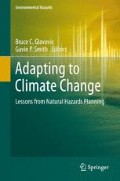Abstract
In this chapter the author argues that resilience must be the primary goal for coastal communities in the future, as they face a series of daunting challenges and future shocks. The chapter examines what resilience means in practice, and identifies a variety of measures and strategies by which coastal communities can become more resilient.
This chapter draws heavily from and expands upon Beatley, Planning for Coastal Resilience, Island Press, 2009.
Access this chapter
Tax calculation will be finalised at checkout
Purchases are for personal use only
References
American Society of Landscape Architects (ASLA). (2008). Landscape structures commits $ 200,000 to sustainable sites initiative. Washington, DC: ASLA. (Press release, June 17).
Beatley, T., Brower, D., & Schwab, A. (2002). An introduction to coastal zone management (2nd ed.). Washington, DC: Island Press.
Beatley, T., & Newman, P. (2008). Green urbanism down under: Learning from Australian sustainable communities. Washington, DC: Island Press.
Beatley, T. (2009). Planning for coastal resilience: Best practices for calamitous times. Washington, DC: Island Press.
Bell, M. L., et al. (2007). Climate change, ambient ozone, and health in 50 U.S. cities. Climate Change, 82, 61–76.
Bergdoll, B. (2011). Rising currents: Projects for New York’s waterfront. New York: MoMA.
Berke, P. R., & Campanella, T. J. (2006). Planning for postdisaster resiliency. The Annals of the American Academy of Political and Social Science, 604, 192–207.
Buckle, P. (2006). Assessing social resilience. In D. Paton & D. Johnston (Eds.), Disaster resilience: An integrated approach (pp. 88–103). Springfield: Charles C. Thomas.
Building Resilient Regions. (Undated). Resilience capacity index. University of California at Berkeley. http://brr.berkeley.edu/rci/.
Campanella, T. J. (2006). Urban resilience and the recovery of New Orleans. Journal of the American Planning Association, 72(2), 141–146.
City of Houston. (2009). Mayor’s task force report: Electric service reliability in the Houston Region. http://www.houstontx.gov/mayor/taskforce-electricity.pdf. Accessed 7 Jan 2014.
Dannenberg, A., Frumkin, H., & Jackson, R. (2011). Making healthy places: Designing and building for health, well-being, and sustainability. Washington, DC: Island Press.
Costanza, R., Mitsch, W. J., & Day, J. W., Jr. (2006). Creating a sustainable and desirable New Orleans. Ecological Engineering, 26, 317–320.
Godschalk, D. R. (2003). Urban hazard mitigation: Creating resilient cities. Natural Hazards Review, 4(3), 136–143.
Gornitz, V., Horton, R., Siebert A., & Rosenzweig, C. (2006). Vulnerability of New York city to storms and sea level rise. Geological Society of American Abstract Programmes, 38(7), 335.
Holling, C. S. (1973). Resilience and stability of ecological systems. Annual Review of Ecology and Systematics, 4, 1–23.
Laushe, B. (2009). Policy tools for local adaptation to sea level rise, Technical report. Sarasota: Mote Marine Laboratory.
McPherson, M., Lynn S.-L., & Bashears, M. (2006). Social isolation in America: Changes in core discussion networks over two decades. American Sociological Review, 71, 353–375.
McGranahan, G., Balk, D., & Anderson, B. (2007). The rising tide: Assessing the risks of climate change and human settlements in low elevation coastal zones. Environment and Urbanization, 19(1):17–37.
McKibben, B. (2011). Eaarth: Making a life on a tough new planet. New York: St. Martins.
Nicholls, R. J., Hanson, S., Herweijer, C., Patmore, N., Hallegatte, S., Corfee-Morlot, J., Chateau, J., & Muir-Wood, R. (2007). Ranking of the world’s cities most exposed to coastal flooding today and in the future. Paris: OECD. http://support.rms.com/publications/OECD_Cities_Coastal_Flooding.pdf. Accessed 7 Jan 2014.
Ouroussoff, N. (2011, March 25). Imagining a more watery New York. New York Times.
Oxfam (2004) “Weathering the Storm: Lessons in Risk Reduction from Cuba,” found at: http://www.eird.org/isdr-biblio/PDF/Cuba%20Weathering.pdf. Accessed 7 Jan 2014.
Paton, D. (2006). Disaster resilience: Building capacity to co-exist with natural hazards and their consequences. In D. Paton & D. Johnston (Eds.), Disaster resilience: An integrated approach (pp. 3–10). Springfield: Charles C. Thomas.
Paton, D., McClure, J., & Burgelt, P. T. (2006). Natural hazard resilience: The role of individual and household preparedness. In D. Paton & D. Johnstone (Eds.), Disaster resilience: An integrated approach. Springfield: Charles C. Thomas.
Putnam, R. D. (2000). Bowling alone: The collapse and revival of American community. Simon and Shuster.
Putnam, R., Feldstein, L., & Cohen, D. (2004). Better together: Restoring the American community. New York: Simon and Shuster
Rotterdam Climate Initiative. (undated). Floating pavilion in the centre of Rotterdam. http://www.rotterdamclimateinitiative.nl/documents/Persberichten/RCP-08102009-English-persbericht-pavilion.pdf. Accessed 6 Jan 2012.
Smith, G. (2011). Planning for post-disaster recovery: A review of the United States disaster assistance framework. Fairfax: Public Entity Risk Institute.
Tobin, G. A., & Montz, B. E. (1997). Natural hazards: Explanation and integration. New York: Guildford Press.
University of Virginia (UVA). (2011). Changing tides: A sea level rise planning analysis for Virginia Beach, VA. Charlottesville.
U.S. Green Building Council. (2005). The New Orleans principles. New Orleans planning Charrette, Nov. pp. 9–11.
Venhaus, H. (2008). Sustainable sites initiative, home energy, July/August. www.homeenergy.org.
Walker, B. S., et al. (2002). Resilience management in social-ecological systems: A working hypothesis for a participatory approach. Conservation Ecology, 6(1), 14.
Walker, B., & Salt, D. (2008). Resilience thinking. Washington, DC: Island Press.
Walker, B., Holling, C. S., Carpenter, S. R., & King, A. (2004). Resilience, adaptability and transformability in social-ecological systems. Ecology and Society, 9(2), 5.
Wilson, A. (2005). Passive survivability. Environmental Building News, 14(12). http://www.buildinggreen.com/auth/article.cfm/2005/12/1/Passive-Survivability/. Accessed 7 Jan 2014.
Wolman, D. (2008). Before the levees break: A plan to save the Netherlands. Wired Magazine. http://www.wired.com/science/planetearth/magazine/17-01/ff_dutch_delta?currentPage=all. Accessed 7 Jan 2014
Author information
Authors and Affiliations
Corresponding author
Editor information
Editors and Affiliations
Rights and permissions
Copyright information
© 2014 Springer Science+Business Media Dordrecht
About this chapter
Cite this chapter
Beatley, T. (2014). Planning for Resilient Coastal Communities: Emerging Practice and Future Directions. In: Glavovic, B., Smith, G. (eds) Adapting to Climate Change. Environmental Hazards. Springer, Dordrecht. https://doi.org/10.1007/978-94-017-8631-7_6
Download citation
DOI: https://doi.org/10.1007/978-94-017-8631-7_6
Published:
Publisher Name: Springer, Dordrecht
Print ISBN: 978-94-017-8630-0
Online ISBN: 978-94-017-8631-7
eBook Packages: Earth and Environmental ScienceEarth and Environmental Science (R0)

